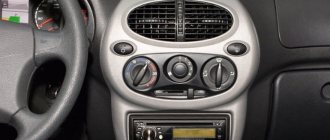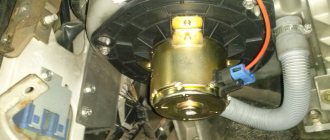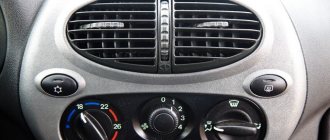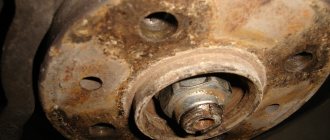As you know, the radiator takes over control of the proper temperature in the Lada Largus, as in other cars. Working closely with it is a complex system of mechanical and electrical components involved in heating the driver and his passengers. Among them are the Lada Largus “Warm Feet” stove deflector, a chisel fan, and a steel casing.
The heater radiator in a car performs the same function as an apartment battery, it heats the space (interior)
How the device works
The above mentioned unit is specially designed for this type of vehicle. Allows you to adjust the direction of hot air movement in relation to seated people. Thus, the concentrated hot jet is mixed with the coolness of the cabin and delivered “to the place of need.”
The essence of the stove is based on reflecting the air flow from above. The laws of physics work perfectly with it: it spreads, creating vacuum and thrust. It is worth noting that the effectiveness of this device increases significantly if it is placed well. The overall increase in traction results in a significant increase in efficiency, raising the level by 20%.
As practice shows, the oven can be made not only of plastic, but also of metal. Of course, the second option will cost less than the first, but in terms of design it still loses. However, plastic is not as durable as metal, so it is preferable for domestically produced cars.
Cooling
To cool the interior air, do the following:
- Switch switch 1 (see Fig. 2) of the electric fan operating modes to one of the positions “1”, “2”, “3” or “4”.
- Place the regulator handle 4 opposite the pictogram.
- In the 3 pushbutton switch block, press the air conditioner switch key. The indicator located on the switch button will light green all the time the air conditioner is operating.
When the air passing through the evaporator cools, the water vapor contained in it condenses. The condensate is drained through a drain pipe under the bottom of the car. If the ambient air humidity is high, a puddle of water may form under the car, which is an indirect sign that the air conditioning system is working properly.
Turning on the air conditioner while the engine is running under difficult conditions (long climbs, heavy city traffic, etc.) can lead to engine overheating. Monitor the coolant temperature gauge: if the temperature exceeds the permissible value, turn off the air conditioner.
- climate block grants
- air duct grants
- air conditioning grants
- stove grants
Lada Granta is one of the most popular cars in Russia in 2022, along with KIA Rio, VW Polo, Lada Vesta, Hyundai Solaris and Hyundai Creta. This popularity of the car is explained, first of all, by the optimal combination of price and quality: Granta owners note good visibility, an acceptable power unit, ease of maintenance, low cost of spare parts, a spacious trunk, high ground clearance, which is extremely important for Russian realities.
Among the components that are indispensable in the cold season is a heater, the main component of which is the radiator. If a situation arises when it is necessary to replace the stove radiator, then in most cases this can be done without outside help. What should the owner of a Lada Granta remember who has decided to replace the heater radiator on his own?
Problems with operating the Lada Largus stove
It is known that the front panel of the Lada Largus was borrowed from Renault Logan. With this in mind, their heating systems are similar. However, the volume of the seven-seater body of the domestic car is much larger than that of the “French”.
Dimensional discrepancy
In winter, passengers may experience some inconvenience due to this difference, which is due to the size and lack of heat in the cabin. Even for the driver, when moving the shock absorbers of the heater, the flow of hot air will not be enough for comfortable driving.
With this in mind, drivers in the first winter of business try to eliminate inaccuracies in the design activities of designers. Most often, a major overhaul of the Largus stove involves closing the distant holes of the nozzle that supplies air to the feet of passengers. This leads to a redistribution of direct heat, increasing its amount.
Engine idling
At the same time, problems with the operation of the stove are often associated with a sharp decrease in hot air when the engine is idling. This can create some inconvenience, especially when driving around the city and getting stuck in traffic jams. The main reason for this is a decrease in the temperature of the antifreeze in the engine cooling system.
To prevent this from happening, you should insulate the compartment in which the engine is located by installing special coatings on the hood. Additionally, several methods can be used to cover the grille.
Fuzzy fan speed switching
If the Largus stove does not heat well, this may also be due to the fact that malfunctions occur when turning the fan speed control knob. When the device does not turn on in any of the modes, the driver must check the condition of the fuses through which voltage is supplied to the fan motor.
If they are also in order, it makes sense to check those components that protect the relay power circuit of the entire heating system. It happens that everything is fine here, so the operating problem lies in the malfunction of the switch itself.
You can understand this by looking at the mounting blocks located in the interior of the Lada Largus. They are located at the end of the front panel or under the hood. It should be noted that the three fan operating modes are activated exclusively through resistance, so in the event of a malfunction, only the fourth mode will be active.
How Lada Largus feels in cold weather
With its appearance on the domestic automobile market, Lada Largus undoubtedly aroused great interest among the interested public.
One of the key questions that potential buyers of this car have is the behavior of the Lada Largus in cold weather. It is immediately worth noting that Largus survived only one winter in operation, but it was quite severe. This made it possible to get a clear idea of how adapted the car is to the conditions of the Russian winter. Judging by the reviews of largus drivers, the car had no problems starting the engine at temperatures down to -30 ºС, which, in principle, is optimal for winter.
Lada Largus performed well in severe frosts
When starting a car in low temperatures, it is important to follow some simple recommendations that are common to many cars. And so, before starting the car, it is advisable to briefly turn on the high beams. The duration of this procedure is from 5 to 30 seconds, but it is immediately clear in what condition the battery is. In addition, the electrolyte begins to warm up, which makes it easier to start the car.
Lada Largus is a car with a manual gearbox. Therefore, before starting, it is advisable to depress the clutch pedal; this also makes starting the engine easier. Directly turning on the ignition and starting the engine in the Lada Largus in cold weather occurs quite clearly and without problems and deserves high praise. Firstly, foreign quality is noticeable, the car is equipped with engines from the Renault family, and secondly, it is still new. This applies to those representatives that are not equipped with an autostart system after a certain time or at a certain temperature. Even open parking on the street does not create any particular disturbance. Those who are equipped with such features, of course, have no problems with starting in winter.
From the moment of start-up until the moment of warming up, the engine speed is kept at 1300-1500 rpm, then this figure drops to 1000 rpm, and during final warm-up it is set at 600-750 rpm. At the same time, the engine operation becomes almost silent.
How to start Lada Largus in severe frost:
Even in severe frosts the car warms up relatively quickly. After 20 minutes, passengers begin to gradually get rid of their outerwear. The owners unanimously claim that you can drive all winter in a light jacket, and at the same time it is quite hot in it, and the air conditioning does not cope well with this. In addition, there is no difference in temperature between the front and rear of the cabin. It’s sad that in Largus there is no provision for measuring the temperature outside the car, which can be found in luxury Kalinas or other representatives of AvtoVAZ, so it is often difficult to assess whether it’s cold outside or not. And even more so, it is almost impossible to monitor changes in ambient temperature during a trip.
A characteristic feature of Largus is the frost that covers the side windows of the car when it is fully loaded with passengers. However, the windows defrost instantly if you just leave the car for a few minutes. But when driving with a minimum load (one or two people), this difficulty does not arise.
In general, Largus coped with the Russian winter very well and thus joined the ranks of its customers who still doubt whether to buy a new product. Moreover, the car earned a positive assessment both in central Russia and in the southern regions of the country. Even Largus owners in cold Siberian regions noted that the car copes with the cold and is suitable for use in difficult winter conditions. At the same time, traveling 600 km from one settlement to another is the norm for the Urals and Siberia, and yet Largus is recognized as suitable for use here.
Largus distinguished itself with good cross-country ability and easy starting at low temperatures
It is also worth saying a few words about the cross-country ability of Largus, because another feature of the Russian winter, in addition to the cold, is the solid snow cover. Therefore, such a characteristic as cross-country ability is also of interest to the public. The vehicle's ground clearance is quite high, which determines the Largus's fairly good cross-country ability.
The car will move as long as there is traction between the wheels and the road surface. As soon as it hits the bottom, the wheels will begin to spin helplessly in the air. The forward and backward movements can make the car move if it is really necessary. You can also get back without any problems. You just have to remember that it is undesirable to drive into a snowdrift at full speed and to put extra pressure on the accelerator pedal. This may end up with the car simply being buried and the help of a shovel no longer necessary.
If there is already a paved track along the route through deep snow and it is not too deep, then Largus will overcome the snowdrifts quite easily. If the track is laid by a car with a higher ground clearance, for example, the same AvtoVAZ Niva, then Largus will not be able to follow such a route, no matter how hard the car is strained, it will stop where the wheels stop gripping the road surface and hang freely to rake the snow mass. This is not a drawback for the car; Largus copes with its direct purpose - to comfortably transport a large number of people or cargo without any complaints.
Troubleshooting the heating system
The functionality of the entire system immediately becomes questionable if the Largus oven is not cleaned before using it after a long pause. This can also be affected by starting the engine when the engine is not running - the coolant does not circulate and the interior stops heating. To somehow solve this situation, you can use one of two methods:
- synchronize the operating mode of the stove with the ignition on, or reinstall the wires of the control relay;
- Connect the thin heater motor wire to partially shielded wires located nearby.
Let's sum up the results
Instead of fixing breakdowns, it is better to prevent them in advance. To do this, you need to regularly replace filters and choose high-quality coolants. These simple tips will help keep your Renault Logan stove in working order for a long time. It is very important to change the cabin filter on time, and in addition, monitor the condition of the cooling system, change antifreeze on time and use only high-quality coolants.
Share with your friends!
Conclusion
To avoid the above problems with the entire heating system, it is necessary to carry out all preventive measures in a timely and comprehensive manner. This will provide the driver and passengers with a smooth ride in the comfort of a well-heated vehicle. The same applies to all cars, regardless of country of origin.
1200 rubles for a photo report
We pay for photo reports on car repairs. Earnings from 10,000 rubles. / Month Write:
Removing and replacing the heater fan, also known as the heater motor, on a Lada Largus car will be much easier than what is written in the instructions about this. The instructions include the following steps:
- remove the entire panel;
- move the air supply knob to the “air blowing in the upper part of the cabin” position;
- on the motor itself, disconnect the power connector;
- While pressing the latch, turn the fan clockwise a quarter turn to remove it from the heater housing.
Of course, such instructions will not help you replace the Largus stove motor in any way, therefore, to make it clearer how to cope with the task, watch popular video instructions that make it possible to get to the stove fan and pull it out of the heater housing much faster.
It is not necessary to remove the dashboard completely to get the heater fan; just bend one edge of the panel (on the side opposite the passenger), remove the windshield pillar cover and, sliding under the glove box, reach the engine with your hand. (located approximately at the same level as the radio). Disconnect the touch connector (squeezing it with your fingers on both sides), remove the lock (above the motor, a little closer to the engine shield), screw it in and pull it out. When it's pulled out, it gets wedged between the dash and the glove box well, so we reach in and pull the dash toward us a little. For replacement, you can choose either a VAZ fan - 272106020 or a Renault - 272106020R, but the price will differ by more than $50.
For more information on how to remove/replace the stove motor assembly with impeller on Largus, see the video.
A very relevant article today (especially in winter): the car’s heater does not heat up or does not heat up very well! Why does this happen and what are the main reasons for it. After all, a normal running car should warm up the interior in 10-15 minutes (unless, of course, you have a turbo engine, there is a partial solution here). If after 15 minutes you just have hot air (or none at all) and all the glass inside is frozen, then that's not "good"! Read my tips below...
First, let's think: how does the car heat up? As we all know, during operation the internal combustion engine becomes very hot, this occurs due to the friction of the pistons against the cylinder walls, as well as due to the combustion of the fuel mixture. If you don't cool the engine, it will quickly fail (the pistons simply jam). The entire cooling system was made of pipes, pipes and radiators, which prevents the power unit from overheating. So, one of the radiators is located inside the cabin, under the dashboard. Without going into complex technical details, it is the heater radiator (heated by engine coolant) that will warm your interior. And in order for the heating efficiency to increase several times, there is a fan nearby (with different operating modes, faster and slower), which blows on this radiator, due to which hot air intensively enters the cabin (both on the glass and on the passengers). And if something disrupts this work process, cold air enters the living room, that is, the stove does not heat up. Now let's talk about the main reasons
There are about five reasons for poor insulation.
Text version
Hello people today on my speedometer. 55 thousand two hundred kilometers and, accordingly, there is snow outside the window, I hope you can see it.
Let's talk about the warmth in the cabin, so the topic of today's video will be about creating comfortable conditions. For transportation in our car, Largus was initially scolded by everyone because it’s not laziness because the car windows don’t heat up, I don’t know, my feet are cold.
And any similar part of these arguments I have the same problems. Like most people, fortunately, no, by the way, as you can see, I’m filming at the time when we have?
Simple opinion
A free five minutes between blinking there I don’t know along the street between the barn and so on, that’s why. Quarreling over the working installation is about the heat, which doesn’t suit me, especially in cold weather when you get into the car. The car is not yet warmed up and well, I worked there for five minutes and warm air came out.
We drive and usually we drive, the heated seats worked, everything was great, we move around, specifically my left leg feels cold. There is no flow cold like in the wind. Nothing is blowing, but something cold is happening in someone’s door due to the cold, and there is such a problem about the fact that the left leg is freezing, there is no such thing.
Although, especially for you, I filmed a moment about how I have this air dock butting on the Odessa side of the meetup, although there is no problem at all. Interesting solutions that are offered on the Internet, I will try something.
Real review
I haven’t gone on a long-distance trip yet this year with regards to both legs and passengers behind these rows. And to be honest, it’s not possible yet because I don’t have enough space to eat in a big crowd so I can move out.
I can’t yet, but someone has a problem with what kind of passengers? The feet of the back rows are cold, so there is food for them. I don’t remember the charter permission, but they developed it, and in my opinion they should already finish the additional stove that is being installed!
Under the passenger seat, that is, if you don’t have enough heat, you can install a second stove and there will be one in the cabin. Tashkent, now I’ll move on to the conditions under which the stoves operate and what modes I use so that I don’t sweat.
Honest Review
There was glass and it was warm in the cabin and the legs and everything else. And since we know our management. By moving the heating control, everything is arranged here from the transmission of this thing, this thing.
Which switches us between sub-flows between different modes, I always have it here and there, rare.
When it’s very wet, I urgently need to warm up the interior, but I dry it so that the front window doesn’t start up, and I’ll turn on this one. Otherwise, I always have the heat on attack! There is a moment when he stands like this.
Review from real owner
There is a moment of phatat, again depending on the temperature, but the stove. This is how it works for me in summer mode.
I always have it at first speed and no matter what temperature it always increases. I have a stove at 1 speed, then in winter it’s always like this, map 7 against the background of engine operation is not very critical: No matter how it puts pressure on my ears in the winter operating mode, my stove is always like this and when it gets hot, suddenly I didn’t do it, I reduce the speed of the stove.
And I lower the temperature, that is, in this case. There is normal air circulation throughout the cabin and, accordingly, the side crowbar could have enough air for us to warm up and warm up, in short.
Largus stove
They didn’t sweat, that is, under such regimes: And accordingly you set it, you take it outside if only in the morning I’m in the comments and start the car well for about ten minutes, I went while I had tea and coffee to drink the car. It warms me up, so I turn it on to warm up and take air from the cabin.
So that it warms up its internal cabin air, we often then take the air!
My felt boots have not been removed from the street, those who know are hidden there in the rear wings.
Additional stove
Felt boots, that is, from the ventilation holes, well, someone. He cleans up, he doesn’t clean up, I didn’t clean up.
I still have them too, and I also have a cabin filter, preferably one. Change it when normal cold weather sets in, why change it because it is after the autumn dust: Dirt, it turns gray due to changes and when it starts.
It is also the first to turn gray because it is wet! He lets moisture through the table, so his appearance begins to sweat; the second problem is that it’s wet, it doesn’t let through so well.
Because of this, the air circulation in the cabin is disrupted, what I would like, what is expected, gray what I want, and so on. Further, the interior of the Varus is unfortunately cold despite its large dimensions: Dimensions, despite the fact that the seven-seater has heating even 3 war 3 rows of rows of seats, by the way, this is the only car at the moment costing up to a million that is 7-seater.
And the second one is essentially the only one in this price range, even in comparison!
With a classmate, Zafer, and so on, who has heated rear seats.
Well, after the pick-up, the legs of the rear passengers in the third row are heated, which is why it’s always like this, all the advantages of the mess solo sera but cold that I would like to want somehow. Should I insulate it because there is a feeling on my leg by the way?
Something like this when the car is cold, when the car warms up, I calmly drove into such problems. No, I want to somehow insulate it, make it quieter, dive like this, to make it more comfortable or something, because after almost two years: Owning a car, I want to improve it a little bit now, if at the first stage everything was fine, initially, now everything is fine, too, but wants something.
To add more of a touch of comfort or something, that’s why who did the Shumka, tell me! What and how to do it, how much do I need in general, this is balyo, that is, Assyria, this is with my humble one.
The budget and the ability to maintain strength, therefore, here are all Buzova’s recommendations, recommendations for your experience, thank you very much right away in our second moment. Also, it was making noise, well, you’ll tell me, in general, I’ll be very grateful, and also the popov’s moment of heated seats. I also want to say right away because there are a lot of complaints?
Insufficient coolant level
Now this is unlikely, since many modern cars have antifreeze level sensors. However, such cases do occur (for example, in cars of previous generations). Imagine: the antifreeze or antifreeze is gone (possibly due to leaking radiators or pipes), the stove does not receive enough heated liquid, and it is practically cold, the fan is blowing and the air is cold (it just doesn’t heat up). It is necessary to add coolant to the level (read how to do this here). Also, if radiators or pipes are leaking, the leak must be repaired.
It is worth noting that if the cooling compound leaks, “air pockets” may form, so even when adding antifreeze, antifreeze must wait a little until the air reaches the level.
Fan replacement
If the stove fan stops working, or it makes strange sounds, then it is necessary to dismantle it, clean it or replace it. However, you should not rush to replace it; first you need to make sure that the brushes of the mechanism are intact, in which case replacement will not be required. Getting to this part is not so easy, but for cars with the Lada “tenth” family design, there is a time-tested reliable way to get to the fan:
- Release the right side of the instrument panel by unscrewing the eight screws, then the panel must be lifted.
- Afterwards it is necessary to remove the standard sound insulation of the engine shield.
- Next, you will need to take a position in the cabin so that your shoulders rest on the mat; this is the easiest way to reach the fan.
Removing the fan is quite simple. All you need is the necessary tools and a little time. By unscrewing the three screws of the casing cover and removing the frame of the radiator pipe seal, you can remove the device. But before changing a part, you need to determine whether it works or not.
After all, it often happens that a dismantled fan spins and functions normally, but as soon as it is put back in place, it immediately ceases to fulfill its direct duties. The reason for this is most often accumulated small particles that prevent normal contact in the mechanism.
Heater radiator is clogged
There may be several reasons:
The first is improper mixing of antifreeze and antifreeze. For example, in a G13 you filled, say, G11 or TOSOL in general, so a sediment may appear that will clog all the thin radiator hoses quite quickly.
Secondly, they poured water. Water not only causes metals in the system to rust, but also forms deposits on the walls.
Thirdly, they eliminated the leakage of the heater radiator or the main radiator using all kinds of sealants. On the one hand we treat, on the other we paralyze. The passages in the radiator can be blocked by excess of this sealant, the liquid cannot circulate normally inside it and, as a result, heat it, which means it will not really heat up. True, your engine can show extremely high temperatures (the main thing is not to overheat). It is necessary to flush the system, clean the radiator, or simply replace the radiator.
Modification of the driver's foot air deflector
To redirect the air flow going to the driver’s feet, it is proposed to make a damper according to a template. A PET bottle or tin can is suitable as a material. Install as shown in the photo:
In addition, it is suggested to trim the carpet in the area (marked in red) so that it does not block the air duct.
The damper now directs the air flow horizontally over the pedals, preventing both of the driver's feet from freezing.
Engine thermostat faulty
Now about more complex failures. If everything is fine with the heater itself, the fan works, but does not heat up well, it may be the engine thermostat.
The thermostat serves to regulate the so-called “cooling circles”. When the engine starts, the coolant flows in a “small circle”; the engine and the internal heater are involved here. Consequently, heating occurs much faster. After the coolant has warmed up, the thermostat opens a “big circle” and the heated liquid and the main radiator, which is located under the hood, have already disappeared. This is done to prevent the engine from overheating if it overheats.
BUT from time to time or due to the quality of the coolant, the thermostat may fail and not close the “big circle”, but always pass through it. Sometimes an absurd situation arises when a small (even) circle slightly overlaps and weakly heated antifreeze (which should heat from the inside) gets into the stove. It blows at full speed (maximum speed), but the air is cold or barely warm. And since at -20, -30 degrees you have to wait for the “big circle” to heat up for a very long time (or maybe not warm up at all), the interior will not heat up.
The only solution is to replace the thermostat! Plus, the faster the better, but it also prevents the glass in your interior from melting, which becomes strained in the winter as visibility decreases.
Comments • 0
-30 feet freeze completely, the stove can’t cope
Tell me where the jack or service button is for the 2014 Largus alarm system.
Found where the fuses are on the left
So you need to ask where you bought it
You don’t have an alarm system, I bought an A 91 with an alarm system. The key fob is broken, to reprogram it, you need to find the jack or service button, I don’t know where it is
Largus does not have a standard signaling system.
but she does the Shumka anyway, she ate and ate herself, after the Shumka she will stop driving completely))))
the same problem or just a feeling that there is a cold sensation near the left leg, I also noticed
I made noise for 2 days myself. with breaks. on trips. according to the material 2 layers vibro. layer of Shumka. I glued 8,000 to the material very meticulously. The interior is easy to disassemble. and assembly is easy. broke the rings from the balloon. changed costs pennies.
@jenya Nik I achieved this effect more silently. I didn’t freeze in it even at -30. I have autostart. and even summer shoes for about 5 years now. Felt boots are lying around in the trunk. Need to check. Didn't the moth eat you?
How much warmer has it become?
With heating you will earn simplicity. You sit warmly, go out into the cold and forgive
My heated seat won't turn off. I rarely turn it on
Hello, anyone reading this is concerned about what gear to put in 5th gear so that you don’t regret it later at a thousand revolutions or at 500 on the K4M engine
Why does the entire right side sweat, although the stove blows equally on both sides?
Look for a damp place
Buy a soldering iron, you won’t be afraid of any frost!
I also feel the cold naked
So don't drive naked
Hello. I came across your video by accident. And I decided to share my experience. I am from central Kazakhstan. I have owned Renault Sandero for seven years. At first it was warm for the first two years. Of course, it takes a long time to warm up, but when it warms up, everything was fine. Then it became cooler although it warmed up the same way. For a long time I could not understand what the problem was. I made the Shumka myself, but only the doors, and additionally glued seals to the doors themselves. This helped a lot. But the car still didn’t have the same warmth as at the beginning. I decided to check the OBD temperature with a scanner and the problem was found. The thermostat was opening early, but you can't see it on the dashboard. Because the pointer is lying. The first two bars light up at 38-40, the next 67-70 and this indicates that the engine is warmed up. And the thermostat itself should maintain an operating temperature of 86-90. After replacing the thermostat, the car became much warmer even than the new one. Although the car takes a long time to heat up, this is a feature of the engine itself. The thermostat was installed original. And additionally I installed an electronic temperature sensor from AliExpress. Now I can see the coolant temperature. Very comfortably. There is another problem that I cannot solve. My side windows are freezing, there is no airflow on them and I don’t know how to make it. Tell me please
Greetings from Tashkent!
greetings from Samara
A friend of mine got frostbite on his leg and his fingers were sucked off.
Hi, you just need to add an electric pump, there will be no problems and you can ride in shorts, verified.
And where to put the electric pump exactly where in detail can you
And you need to install it where the air release valve is located (jumper), and you definitely need to put a relay and a toggle switch so that you can turn it off.
I left for one winter. It was a little cold. In general it's ok.
I can help you soundproof Larguse with 4 doors, a ceiling, a floor and a trunk. Price 22,000 rubles
Soundproof your car completely. Largus costs 38,000 at a car service center.
Damn, it’s a Russian car and they want comfort from it), take it and carry potatoes.
On the grant, my left leg also feels cold.
Put the recirculation in the middle and it will be warm.
how to install recirculation I have it in the middle
Guys! Is the Largus much higher on 16th wheels in winter? Is there an all-season version for the Largus?
I took an all-season car from the showroom; before the Largus I drove the same all-season car on the Volga. There is one for this size “Kamovskaya” for sure
Why heat the seat? Are you sitting on a stool in Largus?
The heated seats can burn out; mine on the driver’s seat burned out in the second year.
in the car like in a bunker. warmth and silence
and all this cost me 25,000 tenge. for rubles approximately 5000
I made no noise myself. it became super. like in a Mercedes. I dismantled the entire interior and glued it with fiberboard, this is a rubber-based plate. and the second layer of self-adhesive type foam insulation 5 mm thick. on the door skin there is a fiber plate under the upholstery, and on the door skin itself there is the same insulation. and on the left leg while walking there is blowing from the speaker
What kind of speedometer is it with BC?
+Sergey Borisovich ferrum
Weird question. whether it gives some insulation to the interior or not. I used vibration and noise to glue the roof, floor, engine partition and double front doors inside and under the map (under the acoustics) on a regular VAZ Seven. The result is quite impressive... much quieter... and much warmer. And by the way, when the JBL acoustics already pump the interior well enough... you can hear practically nothing on the street! Also a cabin with a sleeping bag of a Merc 1120 cargo truck with a cabin tuned by a German studio. (widened by 16 cm and with a high roof - a globe, so that you can move around the cabin at full height) Those who know this series are aware that the factory cabins with sleepers are CATASTROPHICALLY COLD in winter!! There, the unfortunate tiny stove from Merc series 508. 609. can’t cope in ANY WAY. A single cabin is still suitable, but the “hut” is simply a DISASTER! So much for Mercedes. In general, I'm tired of freezing. I dismantled the entire cabin. The floor and the engine tunnel and as far as the front shield of the cabin reached, with ordinary foil-coated 4 mm isolon. The back wall, roof, sides of the sleeping area below the windows are covered with at least 3 cm of cotton wool, with gaps along the vertical and horizontal stiffeners. I decided that air should flow. Everything is dotted with 88 glue. I didn't do anything to the doors at all. The result exceeded all expectations. Silence!! Warm. And the cabin stays warm for a long time!! The “dew point” from the roof lining has disappeared, as before (for all trucks) there were at least wet spots on the ceiling lining from condensation, and at most dripping condensation from the ceiling when the car was stationary and heated by the autonomous system. During downtime, the battery's solar power consumption and its operating power immediately noticeably decreased. because the cabin retains heat and warms up quickly. In the summer, HUGE and even somewhat unexpected advantages emerged. After stopping, the engine tunnel ceased to be a mini frying pan. And the cabin DOES NOT HEAT to the point of a brazier in the sun. In the cabin during the day, when it’s hot, you can sleep comfortably and not sweat.
What could have happened to the stove, it was heating well, now it’s heating a little? If you know, please tell me, I will be grateful to you, thank you.
Engine pump faulty
A pump is essentially a mechanical (sometimes electric) pump motor that moves hot fluid through a system. That is, from the power unit block through the pipes and further into the radiators for cooling. And in our case, for heating the interior.
This is an "impeller" inserted into a metal cylinder through which the liquid passes. The impeller rotates, pushing antifreeze (TOSOL) through the system. If there were no pump, engine cooling would be extremely ineffective and it would quickly overheat.
Most often, the pump is driven by a belt drive from the drive shaft of the power unit.
The main breakdowns are as follows:
- Sometimes the crankshaft belt breaks and the pump does not rotate and does not move “coolant” through the system. As a result, the stove does not heat up. However, the power unit also overheats.
- Seize the pump itself. The inside of the “impeller” does not rotate or rotate.
- Eat inside. Due to the “crappy” quality of the metal, the inner impeller can be eaten by aggressive antifreeze or antifreeze. Thus, purely physically, the pump pulley rotates, but the liquid pumps the system very poorly. Again, the stove does not heat up.
For all reasons, the pump must be replaced. I’ll say right away that the first “calls” could be: a whistle in the engine compartment, a hot pipe to the pump or stove, and then it’s cold.
Messages 1 to 25 of 210
1 Topic by Anthyza 2012-01-11 12:24:58
Topic: Stove won't heat
The stove stopped heating. Cold air is blowing. Tell me what is the cause of the malfunction and how to deal with it.
2012-01-11 12:28:39
2 Reply from Igor Petrovich1 2012-01-11 12:28:39
Re: Stove doesn't heat
Check what position the temperature control is in.
3 Reply from Anthyza 2012-01-11 12:38:21
Re: Stove doesn't heat
Temperature adjustment at maximum position
4 Reply from niknik 2012-01-11 12:49:17
Re: Stove doesn't heat
If the coolant was changed before, then the system is aired out, if not, then check the temperature of the hoses going into the cabin to the stove, both should be hot, if everything is OK, then the drive (temperature regulator) remains, the cable may have flown off or broken.
5 Reply from Anthyza 2012-01-11 13:04:52
Re: Stove doesn't heat
If the coolant was changed before, then the system is aired out, if not, then check the temperature of the hoses going into the cabin to the stove, both should be hot, if everything is OK, then the drive (temperature regulator) remains, the cable may have flown off or broken.
The coolant was changed in May 2011, the stove was not used after the replacement. The temperature of the supply pipe is significantly higher than the temperature of the return pipe. It started when the stove stopped working at times. There is a fitting on the supply pipe, unscrew the cap, put a tube on it (the other end of the tube into the expansion tank), at an engine speed of 1.5-2 thousand. air was leaving the system. After this, the stove heated normally for several days. Now this does not help, cold air is blowing.
6 Reply from mekena 2012-01-11 13:48:22
Re: Stove doesn't heat
The stove may not heat for two reasons. The first is that the system is airy after replacing the antifreeze in the car’s cooling system, the second is that the cylinder head gasket or, simply put, the cylinder head gasket is broken and, as a result, the cooling system is constantly airy. Check for airiness. With the engine cold and not running, we unscrew the cap from the radiator, which is connected to the outlet valve onto the expansion tank for overflowing antifreeze, and begin to pump the system by hand, by squeezing and unclenching the hoses that go to the radiator. Usually, if there is a plug, bubbles will appear after some time, and after pumping they will disappear. You won't be able to get all the air out at once. You will need to start the car (with the radiator cap already screwed on), let it run for two minutes and then repeat the procedure. Since the engine is unlikely to warm up in 2 minutes, the pressure in the system will be minimal, but still unscrew the cap carefully with a dense and thick rag to avoid a sharp splash of hot antifreeze on you and, as a result, getting burns. https://autonovice.com/2008/11/18/ne-greet-pechka.html
Logan Ambiance-1.6 (2006-2014)
7 Reply from niknik 2012-01-11 16:53:01 Edited by niknik (2012-01-11 16:56:43)
Re: Stove doesn't heat
If the cylinder head gasket, I think the problem would come out, the antifreeze level would go down or the engine would cause condensation on the oil dipstick, etc. As a rule, coolant is poured onto a cold engine in small portions with the cap unscrewed until coolant flows out of the cap hole. Tighten the cap and add coolant to the level. CAREFULLY warm up the engine until the thermostat is activated, the radiator should be all hot. (First, the engine itself warms up to operating temperature and then the radiator If does it all heat up at once or just the engine - change the thermostat.) WATCH THE COOLANT!! Wait for the cooling fan to operate. Check the temperature of the inlet and outlet pipes of the heater. Look at the temperature NO MORE THAN 4 divisions. Let the engine cool down. Add coolant to the required level. Everything should be OK! We exclude dirt from getting into the stove.
8 Reply from Donpedro 2012-01-11 18:41:49
Re: Stove doesn't heat
In Russia Forums there are cases of clogging of the heater radiator. They rejoiced at being washed under pressure.
9 Reply from niknik 2012-01-13 23:25:00 Edited by niknik (2012-01-13 23:26:18)
Re: Stove doesn't heat
10 Reply from Saddam Hussein 1 2012-01-25 09:29:48
Re: Stove doesn't heat
It didn't heat up for me either. I topped up the coolant and everything is fine.:patsak:
11 Reply from sLogan 2012-01-25 14:39:26
Re: Stove doesn't heat
Anthyza , I quickly read your post: “I stopped BAKING BUCKWHEAT. »
12 Reply from MARTIN 2012-10-31 23:30:58
Re: Stove doesn't heat
Damn, with the onset of cold weather I encountered the same problem - the stove heats sooooo weakly! Tomorrow I will use MEKENA's advice. The coolant level does not go down. I hope that it is airy due to replacing the thermostat. If it doesn’t help, you’ll have to disassemble and clean it, although some advise rinsing it with XADO flushing, but I’m afraid that it will leak everywhere!
13 Reply from MARTIN 2012-10-31 23:32:53
Re: Stove doesn't heat
By the way, has anyone tried flushing the cooling system?
14 Reply from Uncle Fedor 2012-11-04 12:50:36
Re: Stove doesn't heat
I have been searching for the cause of the stove failure for more than a week. Airing, malfunction of the pump, and breakthrough of gases from the combustion chamber were ruled out. The coolant was replaced as written, at the KA service station. Looks like he's on the trail of the cause. Yesterday I found floating circles in the expansion tank, sort of like oil, but when I tried to touch the circles they sank. I discovered a PCB type plate drifting under the coolant layer. I took it out of the tank with tongs. It turned out that something from the coolant composition was separated and polymerized. Such rubbish was poured onto the spacecraft; in other places, coolant was not poured or added. I drained the fluid from the reservoir, rinsed it with water and added water to the level (I did not add coolant from the spacecraft that was included in the kit after replacement). I went home. It was too late. In the morning I opened the expansion tank. It is full of fragments of the plasticized crap that was poured onto the spacecraft. I drained it again, washed it, and added water. The stove came to life a little. Until the evening I plan to drain all the liquid from the spacecraft, flush the system with water, blow the stove in the direction opposite to the movement of the liquid and fill it with coolant. I really don’t know which one. The advice here is very clever. Symptoms of the problem - eliminating airflow through the standard outlet helps sluggishly; fluid flows through the heater radiator, but the supply is hot, the return is lukewarm; the air entering the cabin is slightly warmed up; the characteristic sounds of air availability are not heard from the heater side; When a large cooling circle is opened, the stove stops even trying to heat the air.
PS I’ll post a photo of the crap that was uploaded to the spacecraft in the evening (I’m writing from my phone), and I’ll post the same result in the evening. KA is now scary as a service, but I have three cars, buy Renault, where to service it.
15 Reply from Uncle Fedor 2012-11-04 12:56:24
Blown engine head gasket
The fact is that the engine is not a monolithic structure; it has a block head and the block itself. They are connected by a special gasket. If this gasket is punctured (and this happens, for example, with poor broaching), the coolant will go into the cylinders or muffler (thick white smoke will come out of the muffler). Consequently, there will not be enough coolant in the system (air pockets may appear) and therefore the stove will heat poorly! Change the cylinder head gasket immediately, otherwise the engine may shut down due to overheating.
These are probably all the main reasons why the oven does not heat well! For my part, I would like to note that in most cases this is a thermostat malfunction (about 70%). So check this first - change it.
Now let's watch a useful short video.
And that's it, read our AUTOBLOG.
(27 votes, average: 4.00 out of 5)
Changing a light bulb
If the regulator illumination light does not light, then you first need to check the fuses. There is one central panel illumination lamp. The absence of damaged fuses means that the light bulb needs to be replaced.
- Remove the radio cover.
- Using a screwdriver, carefully pry off the gray panel.
- Remove the handles that control the fan, air flow and heater.
- Unscrew the screws securing the module.
- Push the module inward and remove the upper part outward.
- Press the latches on the sides and bend the panel. It is difficult to remove the panel; just bend it off.
- This is where the backlight bulb lives. Replace it with a new one and reassemble everything in reverse order.
After a simple procedure, the backlight works again.
Source











